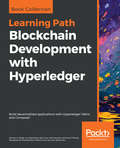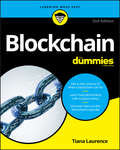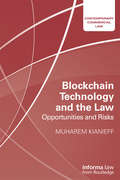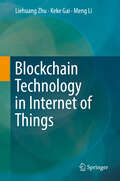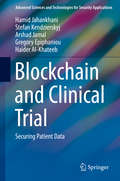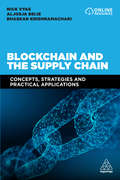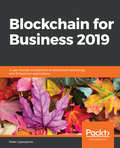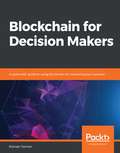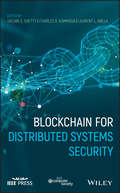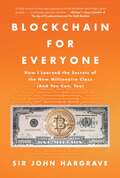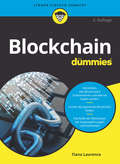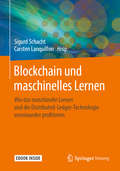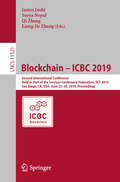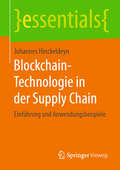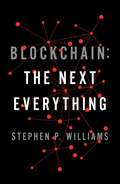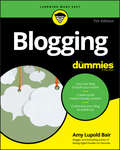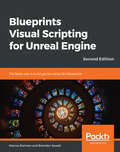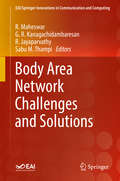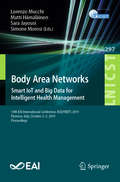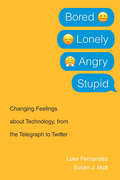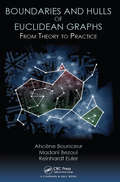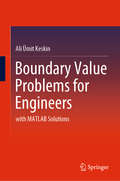- Table View
- List View
Blockchain Development with Hyperledger: Build decentralized applications with Hyperledger Fabric and Composer
by Luc Desrosiers Nitin Gaur Petr Novotny Venkatraman Ramakrishna Anthony O'Dowd Weimin Sun Xun (Brian) Wu Salman A. BasetLearn quick and effective techniques for developing blockchain-based distributed ledgers with easeKey FeaturesDiscover why blockchain is a game changer in the technology landscapeSet up blockchain networks using Hyperledger FabricWrite smart contracts at speed with Hyperledger ComposerBook DescriptionBlockchain and Hyperledger are open source technologies that power the development of decentralized applications. This Learning Path is your helpful reference for exploring and building blockchain networks using Ethereum, Hyperledger Fabric, and Hyperledger Composer.Blockchain Development with Hyperledger will start off by giving you an overview of blockchain and demonstrating how you can set up an Ethereum development environment for developing, packaging, building, and testing campaign-decentralized applications. You'll then explore the de facto language Solidity, which you can use to develop decentralized applications in Ethereum. Following this, you'll be able to configure Hyperledger Fabric and use it to build private blockchain networks and applications that connect to them. Toward the later chapters, you'll learn how to design and launch a network, and even implement smart contracts in chain code. By the end of this Learning Path, you'll be able to build and deploy your own decentralized applications by addressing the key pain points encountered in the blockchain life cycle.This Learning Path includes content from the following Packt products:Blockchain Quick Start Guide by Xun (Brian) Wu and Weimin SunHands-On Blockchain with Hyperledger by Nitin Gaur et al.What you will learnUnderstand why decentralized applications are necessaryDevelop and test a decentralized application with Hyperledger Fabric and Hyperledger ComposerWrite and test a smart contract using SolidityDesign transaction models and chain code with GolangDeploy the Composer REpresentational State Transfer (REST) Gateway to access Composer transactionsMaintain, monitor, and manage your blockchain solutionsWho this book is forThis Learning Path is designed for blockchain developers who want to build decentralized applications and smart contracts from scratch using Hyperledger. Basic familiarity with or exposure to any programming language will be useful to get started with this course.
Blockchain For Dummies
by Tiana LaurenceUnravel the mysteries of blockchains Blockchain technologies are disrupting some of the world’s biggest industries. Blockchain For Dummies provides a fast way to catch up with the essentials of this quickly evolving tech. Written by an author involved in founding and analyzing blockchain solutions, this book serves to help those who need to understand what a blockchain can do (and can't do). This revised edition walks you through how a blockchainsecurely records data across independent networks. It offers a tour of some of the world’s best-known blockchains, including those that power Bitcoin and other cryptocurrencies. It also provides a glance at how blockchain solutions are affecting the worlds of finance, supply chain management, insurance, and governments. Get a clear picture of what a blockchain can do Learn how blockchains rule cryptocurrency and smart contracts Discover current blockchains and how each of them work Test blockchain apps Blockchain has become the critical buzzword in the world of financial technology and transaction security — and now you can make sense of it with the help of this essential guide.
Blockchain Technology and the Law: Opportunities and Risks (Contemporary Commercial Law)
by Muharem KianieffBlockchain Technology and the Law: Opportunities and Risks is one of the first texts to offer a critical analysis of Blockchain and the legal and economic challenges faced by this new technology. This book will offer those who are unfamiliar with Blockchain an introduction as to how the technology works and will demonstrate how a legal framework that governs it can be used to ensure that it can be successfully deployed. Discussions included in this book: - an introduction to smart contracts, and their potential, from a commercial and consumer law perspective, to change the nature of transactions between parties; - the impact that Blockchain has already had on financial services, and the possible consumer risks and macro-economic issues that may arise in the future; - the challenges that are facing global securities regulators with the development of Initial Coin Offerings and the ongoing risks that they pose to the investing public; - the risk of significant privacy breaches due to the online public nature of Blockchain; and - the future of Blockchain technology. Of interest to academics, policy-makers, technology developers and legal practitioners, this book will provide a thorough examination of Blockchain technology in relation to the law from a comparative perspective with a focus on the United Kingdom, Canada and the United States.
Blockchain Technology in Internet of Things
by Meng Li Liehuang Zhu Keke GaiThis book focuses on picturing B-IoT techniques from a few perspectives, which are architecture, key technologies, security and privacy, service models and framework, practical use cases and more. Main contents of this book derive from most updated technical achievements or breakthroughs in the field. A number of representative IoT service offerings will be covered by this book, such as vehicular networks, document sharing system, and telehealth. Both theoretical and practical contents will be involved in this book in order to assist readers to have a comprehensive and deep understanding the mechanism of using blockchain for powering up IoT systems. The blockchain-enabled Internet of Things (B-IoT) is deemed to be a novel technical alternative that provides network-based services with additional functionalities, benefits, and implementations in terms of decentralization, immutability, and auditability. Towards the enhanced secure and privacy-preserving Internet of Things (IoT), this book introduces a few significant aspects of B-IoT, which includes fundamental knowledge of both blockchain and IoT, state-of-the-art reviews of B-IoT applications, crucial components in the B-IoT system and the model design, and future development potentials and trends.IoT technologies and services, e.g. cloud data storage technologies and vehicular services, play important roles in wireless technology developments. On the other side, blockchain technologies are being adopted in a variety of academic societies and professional realms due to its promising characteristics. It is observable that the research and development on integrating these two technologies will provide critical thinking and solid references for contemporary and future network-relevant solutions. This book targets researchers and advanced level students in computer science, who are focused on cryptography, cloud computing and internet of things, as well as electrical engineering students and researchers focused on vehicular networks and more. Professionals working in these fields will also find this book to be a valuable resource.
Blockchain and Clinical Trial: Securing Patient Data (Advanced Sciences and Technologies for Security Applications)
by Hamid Jahankhani Arshad Jamal Stefan Kendzierskyj Gregory Epiphaniou Haider Al-KhateebThis book aims to highlight the gaps and the transparency issues in the clinical research and trials processes and how there is a lack of information flowing back to researchers and patients involved in those trials. Lack of data transparency is an underlying theme within the clinical research world and causes issues of corruption, fraud, errors and a problem of reproducibility. Blockchain can prove to be a method to ensure a much more joined up and integrated approach to data sharing and improving patient outcomes. Surveys undertaken by creditable organisations in the healthcare industry are analysed in this book that show strong support for using blockchain technology regarding strengthening data security, interoperability and a range of beneficial use cases where mostly all respondents of the surveys believe blockchain will be important for the future of the healthcare industry. Another aspect considered in the book is the coming surge of healthcare wearables using Internet of Things (IoT) and the prediction that the current capacity of centralised networks will not cope with the demands of data storage. The benefits are great for clinical research, but will add more pressure to the transparency of clinical trials and how this is managed unless a secure mechanism like, blockchain is used.
Blockchain and the Supply Chain: Concepts, Strategies and Practical Applications
by Bhaskar Krishnamachari Nick Vyas Aljosja BeijeBlockchain can transform companies, if it is successfully integrated into existing supply chain ecosystems and practices. Some of the key benefits are dispute resolution, foolproof track and trace, event management, operational as well as financial transparency, speed to market, visibility, elimination of heavy reliance on intermediary, integration of IoT technology, machine learning, and artificial intelligence. Blockchain and the Supply Chain highlights how blockchain can enable opportunities within the end-to-end supply chain.The team of authors look at the evolution of the network, systems and finance, as well as basics of blockchain such as peer-to-peer transactions, consensus based algorithms and smart contracts. They include cases which highlight the opportunities within the different nodes of systems, sales and operations planning and provide practical examples from specific supply chains, such as the movement of temperature controlled goods, dry goods and precious commodities, as well as general cargo flow. Blockchain and the Supply Chain examines the business case for blockchain, including increased efficiency of transactions. It also covers the broader set of technologies relevant to supply chain, such as IoT, Big Data and Cyber Security basics and the capabilities they offer.
Blockchain for Business 2019: A user-friendly introduction to blockchain technology and its business applications
by Peter LipovyanovYour one-stop guide to blockchain technology and its business applications Key Features Assimilate blockchain services such as Ethereum and Hyperledger to transform industrial applications Know in and out of blockchain technology to understand various business use cases Understand various common and not-so-common challenges faced in blockchain development Book Description Blockchain for Business 2019 is a comprehensive guide that enables you to bring in various blockchain functionalities to extend your existing business models and make correct fully-informed decisions. You will learn how decentralized applications are transforming numerous business sectors that are expected to play a huge role in the future. You will see how large corporations are already implementing blockchain technology now. You will then learn about the various blockchain services, such as Bitcoin, Ethereum, Hyperledger, and others to understand their use cases in a variety of business domains. You will develop a solid fundamental understanding of blockchain architecture. Moving ahead, you will get to grips with the inner workings of blockchain, with detailed explanations of mining, decentralized consensus, cryptography, smart contracts, and many other important concepts. You will delve into a realistic view of the current state of blockchain technology, along with its issues, limitations, and potential solutions that can take it to the next level. By the end of this book, you will all be well versed in the latest innovations and developments in the emerging blockchain space. What you will learn Understand the fundamentals of blockchain and how it was developed Gain a good understanding of economic concepts and developments Develop a base for concepts such as cryptography, computer networking, and programming Understand the applications of blockchain and its potential impact on the world Become well versed with the latest developments in the blockchain space Explore blockchain frameworks, including decentralized organizational structures, networks, and applications Who this book is for This book is for financial professionals, business executives, managers, and enthusiasts who are interested in getting well-versed with blockchain technology in various business domains. This book will help boost your existing business models using blockchain services. No prior experience of blockchain is required.
Blockchain for Decision Makers: A systematic guide to using blockchain for improving your business
by Romain TormenUnderstand how blockchain works and explore a variety of strategies to implement it in your organization effectively Key Features Become familiar with business challenges faced by companies when using blockchain Discover how companies implement blockchain to monetize and secure their data Study real-world examples to understand blockchain and its use in organizations Book Description In addition to cryptocurrencies, blockchain-based apps are being developed in different industries such as banking, supply chain, and healthcare to achieve digital transformation and enhance user experience. Blockchain is not only about Bitcoin or cryptocurrencies, but also about different technologies such as peer-to-peer networks, consensus mechanisms, and cryptography. These technologies together help sustain trustless environments in which digital value can be transferred between individuals without intermediaries. This book will help you understand the basics of blockchain such as consensus protocols, decentralized applications, and tokenization. You'll focus on how blockchain is used today in different industries and the technological challenges faced while implementing a blockchain strategy. The book also enables you, as a decision maker, to understand blockchain from a technical perspective and evaluate its applicability in your business. Finally, you'll get to grips with blockchain frameworks such as Hyperledger and Quorum and their usability. By the end of this book, you'll have learned about the current use cases of blockchain and be able to implement a blockchain strategy on your own. What you will learn Become well-versed with how blockchain works Understand the difference between blockchain and Bitcoin Learn how blockchain is being used in different industry verticals such as finance and retail Delve into the technological and organizational challenges of implementing blockchain Explore the possibilities that blockchain can unlock for decision makers Choose a blockchain framework best suited for your projects from options such as Ethereum and Hyperledger Fabric Who this book is for This book is for CXOs, business professionals, organization leaders, decision makers, technology enthusiasts, and managers who wish to understand how blockchain is implemented in different organizations, its impact, and how it can be customized according to business needs. Prior experience with blockchain is not required.
Blockchain for Distributed Systems Security
by Charles A. Kamhoua Sachin S. Shetty Laurent L. NjillaAN ESSENTIAL GUIDE TO USING BLOCKCHAIN TO PROVIDE FLEXIBILITY, COST-SAVINGS, AND SECURITY TO DATA MANAGEMENT, DATA ANALYSIS, AND INFORMATION SHARING Blockchain for Distributed Systems Security contains a description of the properties that underpin the formal foundations of Blockchain technologies and explores the practical issues for deployment in cloud and Internet of Things (IoT) platforms. The authors—noted experts in the field—present security and privacy issues that must be addressed for Blockchain technologies to be adopted for civilian and military domains. The book covers a range of topics including data provenance in cloud storage, secure IoT models, auditing architecture, and empirical validation of permissioned Blockchain platforms. The book's security and privacy analysis helps with an understanding of the basics of Blockchain and it explores the quantifying impact of the new attack surfaces introduced by Blockchain technologies and platforms. In addition, the book contains relevant and current updates on the topic. This important resource: Provides an overview of Blockchain-based secure data management and storage for cloud and IoT Covers cutting-edge research findings on topics including invariant-based supply chain protection, information sharing framework, and trust worthy information federation Addresses security and privacy concerns in Blockchain in key areas, such as preventing digital currency miners from launching attacks against mining pools, empirical analysis of the attack surface of Blockchain, and more Written for researchers and experts in computer science and engineering, Blockchain for Distributed Systems Security contains the most recent information and academic research to provide an understanding of the application of Blockchain technology.
Blockchain for Everyone: How I Learned the Secrets of the New Millionaire Class (And You Can, Too)
by Sir John HargraveFrom the author of Mind Hacking and founder of Bitcoin Market Journal comes the first book to explain the money-making secrets behind bitcoin and blockchain in a user-friendly format. When John Hargrave first invested in cryptocurrency, the price of a single bitcoin was about $125; a few years later, that same bitcoin was worth $20,000. He wasn’t alone: this flood of new money is like the early days of the Internet, creating a new breed of “blockchain billionaires.” Sir John has unlocked their secrets. In Blockchain for Everyone, Sir John reveals the formula for investing in bitcoin and blockchain, using real-life stories, easy-to-understand examples, and a healthy helping of humor. Packed with illustrations, Blockchain for Everyone explains how (and when) to buy bitcoin, cryptocurrencies, and other blockchain assets, with step-by-step instructions. Blockchain for Everyone is the first blockchain investing book written for the layperson: a guide that helps everyone understand how to build wealth wisely. It’s the new investing manifesto!
Blockchain für Dummies (Für Dummies)
by Tiana LaurenceDie Blockchain-Technologie verspricht, den Finanzmarkt, die Versicherungsbranche, das Supply-Chain-Management und andere Branchen zu revolutionieren. Aber Sie müssen kein Tech-Nerd sein, um die Blockchain zu verstehen. Dieses Buch erklärt die Grundlagen und wichtige Anwendungen wie Kryptowährungen und Smart Contracts. Reale Beispiele machen deutlich, wie Blockchains funktionieren und wo ihr Mehrwert liegt. Erstellen Sie eine eigene Blockchain, schauen Sie sich die wichtigsten Blockchain-Anbieter an, erkennen Sie das Disruptionspotenzial für eingesessene Industrien und vieles mehr.
Blockchain und maschinelles Lernen: Wie das maschinelle Lernen und die Distributed-Ledger-Technologie voneinander profitieren
by Sigurd Schacht Carsten LanquillonDurch Bitcoin wurde die Blockchain als zugrundeliegende Technologie bekannt. Sie zählt zu den Distributed-Ledger-Technologien, die zukünftig viele Bereiche des wirtschaftlichen Handels beeinflussen werden. So bergen dezentrale autonome Anwendungen enormes Potenzial, nicht nur Prozesse, sondern auch Vertragsabstimmungen zu automatisieren. Beispielsweise kann ein automatisiertes wirtschaftliches Handeln zwischen Maschinen ermöglicht werden. Um einen derart hohen Automatisierungsgrad zu erreichen, müssen datenbasierte Entscheidungen autonom – ohne menschliches Zutun – getroffen werden. Maschinelle Lernverfahren können dabei eine zentrale Komponente bei der Entscheidungsfindung einnehmen. Das Buch stellt erstmalig die komplementären Themengebiete Distributed-Ledger-Technologie und maschinelles Lernen gegenüber und zeigt auf, welches Potenzial freigesetzt werden kann, wenn beide Technologien zielführend miteinander verbunden werden. Das Buch ist eine unverzichtbare Lektüre für diejenigen, die sich tiefgreifendes Wissen in der Kombination beider Themengebiete aufbauen wollen, indem einerseits die theoretischen Grundlagen und andererseits auch mögliche Anwendungsszenarien dargestellt werden.
Blockchain – ICBC 2019: Second International Conference, Held as Part of the Services Conference Federation, SCF 2019, San Diego, CA, USA, June 25–30, 2019, Proceedings (Lecture Notes in Computer Science #11521)
by Qi Zhang Surya Nepal Liang-Jie Zhang James JoshiThis book constitutes the refereed proceedings of the Second International Conference on Blockchain, ICBC 2019, held as part of the Services Conference Federation, SCF 2019, in San Diego, CA, USA, in June 2019. The 13 full papers and 2 short papers presented were carefully reviewed and selected from 29 submissions. The papers cover a wide range of topics in blockchain technologies, platforms, solutions and business models such as new blockchain architecture, platform constructions, blockchain development and blockchain services technologies, as well as standards, and blockchain services innovation lifecycle including enterprise modeling, business consulting, solution creation, services orchestration, services optimization, services management, services marketing, business process integration and management.
Blockchain-Technologie in der Supply Chain: Einführung und Anwendungsbeispiele (essentials)
by Johannes HinckeldeynSeit der Einführung des Bitcoin hat die zugrunde liegende Blockchain steigende Aufmerksamkeit erfahren, begründet durch das hohe Maß an Manipulationssicherheit dieser Technologie. Als wichtiges Anwendungsfeld für Blockchain wird dabei häufig die Lieferkette von Unternehmen genannt. Johannes Hinckeldeyn gibt in diesem essential eine Einführung in die Blockchain-Technologie mit besonderem Fokus auf Logistik und Lieferkette. Er stellt verschiedene Blockchains und System-Architekturen vor, diskutiert – basierend auf realen Projekten – generische Anwendungsfälle und leitet Empfehlungen ab.
Blockchain: A Short Guide To Blockchain
by Stephen P. WilliamsAn experienced tech writer fully explains blockchain technology and how it will radically transform the world as we know it in this accessible, reader-friendly, illuminating guide.What is blockchain? Why does everyone from tech experts to business moguls to philanthropists believe it is a paradigm-shifting technology, bound to revolutionize society as significantly as the internet? Indeed, why is blockchain touted as The Next Everything? In this deft, fascinating, and easy-to-digest introduction to one of the most important innovations of recent times, Stephen P. Williams answers these questions, revealing how cryptocurrencies like bitcoin are just one example among dozens of transformative applications that this relatively new technology makes possible. He interprets the complexity into digestible anecdotes, metaphors, and straightforward descriptions for readers who don’t know tech, and explains all of blockchain’s most important aspects: why this so-called digital ledger is unhackable and unchangeable; how its distributed nature may transfer power from central entities like banks, government, and corporations to ordinary citizens around the world; and what its widespread use will mean for society as a whole. Taking us on a dazzlingly vivid tour through the systems predicted to soon underpin economics, politics, global trade, science, art, and numerous other aspects of our everyday lives, Blockchain: The Next Everything is a truly extraordinary journey into our future.
Blogging For Dummies
by Amy Lupold BairThe bestselling blogging book—updated in a new edition! Ready to make your mark on the online world? Start a blog! Blogging For Dummies provides you with information on blogging basics, the anatomy of a good blog, and the tools required to get started. Plus, you'll get advice on a blog topic, choosing a domain name and host, writing your first post, planning an editorial calendar, and using your blog as an important part of your personal brand. Decide which of the major blogging platforms will work for you Use SEO to drive traffic to your blog Monetization through advertising and sponsorships Create content that draws readers in Covering shifts in popular blogging platforms and tools, changes in social media, and the latest best practices in the blogosphere, this new edition sets you up for blogging success!
Blogging: La mejor pequeña guía para administrar un blog redituable
by Isaac KronenbergSeguro que ya has escuchado esto antes, sólo escoge el nicho apropiado, escribe buenos artículos, esparce vínculos de afiliación por todos lados, y obtendrás ganancias. Bueno, ¡tengo noticias para ti! ¡Eso NO es lo que hacen los blogueros que obtienen grandes ganancias! Aunque hay algo de cierto en el hecho de que parte de la ecuación es generar vínculos de afiliación para tu blog, sólo esparcirlos al azar y esperar que alguien de un cliqueo no es una buena estrategia en absoluto. Entonces, este libro se concentra en revelarte exactamente lo que los blogueros que obtienen grandes ganancias realmente hacen (que es lo que hago exactamente yo). No cometas errores, la mayoría que comienza un blog no tiene ni idea de cómo monetizarlo, y fallan en lograr que el blog sea redituable; esa es la realidad, tu competición es muy baja si haces las cosas bien, si haces lo que te indico en este libro. De hecho, no tendrás que leer otro libro sobre blogging nuevamente porque sabrás exactamente lo que tienes que hacer para monetizar tu blog. Confía en mí, este libro será el mejor libro sobre blogging que jamás hayas leído, y te mostrará un mapa muy real y directo para asegurarte que obtengas ganancias desde tu blog. La única manera de fracasar es no implementar el método que te enseñaré, así que asegúrate no sólo de leer este libro en forma pasiva sino realmente aplicando lo que te vaya indicando, ya que estoy absolutamente seguro de que logrará llevar tu blog a otro nivel.
Blogging: Obtén US$ 2000 al mes en 90 días
by Isaac Kronenberg¡Isaac Kronenberg lo logra de nuevo, otro libro fascinante sobre blogging que va más allá de cualquier otro libro que ya exista! Este último libro de Kronenberg es el libro sobre blogging más avanzado del mercado, enseñando nada más ni nada menos que las estrategias más efectivas de monetizar que existen para obtener un blog que genere de cero a US$2000 por mes en 90 días. Todo lo que está incluido en este libro está basado en estrategias reales utilizadas por blogueros que generan muchos ingresos en la actualidad. Ya sea que seas nuevo en el blogging o un bloguero avanzado, si existe una píldora mágica que puede llevarte de cero a generar un ingreso a tiempo completo de un blog, entonces este libro es el objeto más cercano que existe a esa píldora mágica. Si en serio te propones generar ingresos con el blogging, entonces este libro será el mejor libro que hayas leído acerca del tema.
Blueprints Visual Scripting for Unreal Engine: The faster way to build games using UE4 Blueprints
by Brenden Sewell Marcos RomeroPublisher\'s note: This edition from 2019 is based on Unreal Engine 4 and does not make use of the most recent Unreal Engine features. A new third edition, updated for Unreal Engine 5 blueprints including new topics, such as implementing procedural generation and creating a product configurator, has now been published.Key FeaturesDesign a fully functional game in UE4 without writing a single line of codeImplement visual scripting to develop gameplay mechanics, UI, visual effects, VR and artificial intelligenceDeploy your game on multiple platforms and share it with the worldBook DescriptionBlueprints is the visual scripting system in Unreal Engine that enables programmers to create baseline systems and can be extended by designers. This book helps you explore all the features of the Blueprint Editor and guides you through using Variables, Macros, and Functions. You’ll also learn about object-oriented programming (OOP) and discover the Gameplay Framework. In addition to this, you’ll learn how Blueprint Communication allows one Blueprint to access information from another Blueprint. Later chapters will focus on building a fully functional game using a step-by-step approach. You’ll start with a basic first-person shooter (FPS) template, and each chapter will build on the prototype to create an increasingly complex and robust game experience. You’ll then progress from creating basic shooting mechanics to more complex systems, such as user interface elements and intelligent enemy behavior. The skills you will develop using Blueprints can also be employed in other gaming genres. In the concluding chapters, the book demonstrates how to use arrays, maps, enums, and vector operations. Finally, you’ll learn how to build a basic VR game. By the end of this book, you’ll have learned how to build a fully functional game and will have the skills required to develop an entertaining experience for your audience.What you will learnUnderstand programming concepts in BlueprintsCreate prototypes and iterate new game mechanics rapidlyBuild user interface elements and interactive menusUse advanced Blueprint nodes to manage the complexity of a gameExplore all the features of the Blueprint editor, such as the Components tab, Viewport, and Event GraphGet to grips with object-oriented programming (OOP) concepts and explore the Gameplay FrameworkLearn Virtual Reality development with UE BlueprintWho this book is forThis book is for anyone who is interested in developing games or applications with UE4. Although basic knowledge of Windows OS is required, experience in programming or UE4 is not necessary.
Blueprints Visual Scripting for Unreal Engine: The faster way to build games using UE4 Blueprints, 2nd Edition
by Brenden Sewell Marcos RomeroDevelop high-quality interactive games with the power of Unreal Engine's visual scripting language and Blueprints framework Key Features Design a fully functional game in UE4 without writing a single line of code Implement visual scripting to develop gameplay mechanics, UI, visual effects, VR and artificial intelligence Deploy your game on multiple platforms and share it with the world Book Description Blueprints is the visual scripting system in Unreal Engine that enables programmers to create baseline systems and can be extended by designers. This book helps you explore all the features of the Blueprint Editor and guides you through using Variables, Macros, and Functions. You'll also learn about object-oriented programming (OOP) and discover the Gameplay Framework. In addition to this, you'll learn how Blueprint Communication allows one Blueprint to access information from another Blueprint. Later chapters will focus on building a fully functional game using a step-by-step approach. You'll start with a basic first-person shooter (FPS) template, and each chapter will build on the prototype to create an increasingly complex and robust game experience. You'll then progress from creating basic shooting mechanics to more complex systems, such as user interface elements and intelligent enemy behavior. The skills you will develop using Blueprints can also be employed in other gaming genres. In the concluding chapters, the book demonstrates how to use arrays, maps, enums, and vector operations. Finally, you'll learn how to build a basic VR game. By the end of this book, you'll have learned how to build a fully functional game and will have the skills required to develop an entertaining experience for your audience. What you will learn Understand programming concepts in Blueprints Create prototypes and iterate new game mechanics rapidly Build user interface elements and interactive menus Use advanced Blueprint nodes to manage the complexity of a game Explore all the features of the Blueprint editor, such as the Components tab, Viewport, and Event Graph Get to grips with object-oriented programming (OOP) concepts and explore the Gameplay Framework Learn Virtual Reality development with UE Blueprint Who this book is for This book is for anyone who is interested in developing games or applications with UE4. Although basic knowledge of Windows OS is required, experience in programming or UE4 is not necessary.
Body Area Network Challenges and Solutions (EAI/Springer Innovations in Communication and Computing)
by Sabu M. Thampi R. Maheswar G. R. Kanagachidambaresan R. JayaparvathyThis book provides a novel solution for existing challenges in wireless body sensor networks (WBAN) such as network lifetime, fault tolerant approaches, reliability, security, and privacy. The contributors first discuss emerging trends of WBAN in the present health care system. They then provide possible solutions to challenges inherent in WBANs. Finally, they discuss results in working environments. Topics include communication protocols of implanted, wearable and nano body sensor networks; energy harvesting methodologies and experimentation for WBAN; reliability analysis and fault tolerant architecture for WBAN; and handling network failure during critical duration. The contributors consist of researchers and practitioners in WBAN around the world.
Body Area Networks: 14th EAI International Conference, BODYNETS 2019, Florence, Italy, October 2-3, 2019, Proceedings (Lecture Notes of the Institute for Computer Sciences, Social Informatics and Telecommunications Engineering #297)
by Simone Morosi Lorenzo Mucchi Matti Hämäläinen Sara JayousiThis book constitutes the refereed post-conference proceedings of the 14th EAI International Conference on Body Area Networks, BodyNets 2019, held in Florence, Italy, in October 2019. The 27 papers presented were selected from 54 submissions and issue new technologies to provide trustable measuring and communications mechanisms from the data source to medical health databases. Wireless body area networks (WBAN) are one major element in this process. Not only on-body devices but also technologies providing information from inside a body are in the focus of this conference. Dependable communications combined with accurate localization and behavior analysis will benefit WBAN technology and make the healthcare processes more effective.
Bored, Lonely, Angry, Stupid: Changing Feelings about Technology, from the Telegraph to Twitter
by Luke FernandezFacebook makes us lonely. Selfies breed narcissism. On Twitter, hostility reigns. Pundits and psychologists warn that digital technologies substantially alter our emotional states. But Luke Fernandez and Susan Matt show that technology doesn’t just affect how we feel from moment to moment—it changes profoundly the underlying emotions themselves.
Boundaries and Hulls of Euclidean Graphs: From Theory to Practice
by Ahcene Bounceur Madani Bezoui Reinhardt EulerBoundaries and Hulls of Euclidean Graphs: From Theory to Practice presents concepts and algorithms for finding convex, concave and polygon hulls of Euclidean graphs. It also includes some implementations, determining and comparing their complexities. Since the implementation is application-dependent, either centralized or distributed, some basic concepts of the centralized and distributed versions are reviewed. Theoreticians will find a presentation of different algorithms together with an evaluation of their complexity and their utilities, as well as their field of application. Practitioners will find some practical and real-world situations in which the presented algorithms can be used.
Boundary Value Problems for Engineers: with MATLAB Solutions
by Ali Ümit KeskinThis book is designed to supplement standard texts and teaching material in the areas of differential equations in engineering such as in Electrical ,Mechanical and Biomedical engineering. Emphasis is placed on the Boundary Value Problems that are often met in these fields.This keeps the the spectrum of the book rather focussed .The book has basically emerged from the need in the authors lectures on “Advanced Numerical Methods in Biomedical Engineering” at Yeditepe University and it is aimed to assist the students in solving general and application specific problems in Science and Engineering at upper-undergraduate and graduate level.Majority of the problems given in this book are self-contained and have varying levels of difficulty to encourage the student. Problems that deal with MATLAB simulations are particularly intended to guide the student to understand the nature and demystify theoretical aspects of these problems. Relevant references are included at the end of each chapter. Here one will also find large number of software that supplements this book in the form of MATLAB script (.m files). The name of the files used for the solution of a problem are indicated at the end of each corresponding problem statement.There are also some exercises left to students as homework assignments in the book. An outstanding feature of the book is the large number and variety of the solved problems that are included in it. Some of these problems can be found relatively simple, while others are more challenging and used for research projects. All solutions to the problems and script files included in the book have been tested using recent MATLAB software.The features and the content of this book will be most useful to the students studying in Engineering fields, at different levels of their education (upper undergraduate-graduate).
